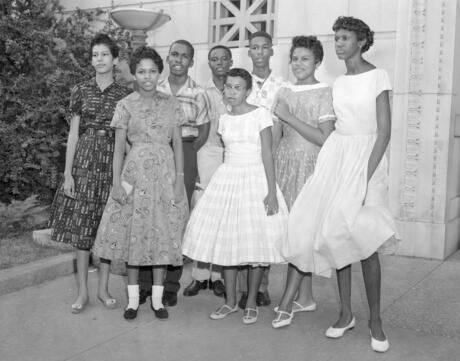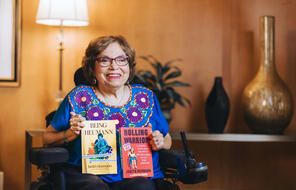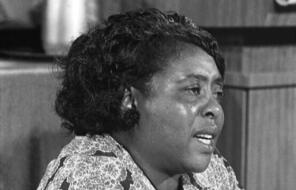
The Little Rock Nine: Connecting 1957 to Today
The Legacy of the Little Rock Nine
In early September 1957 nine Black high school students—Minnijean Brown, Terrance Roberts, Elizabeth Eckford, Ernest Green, Thelma Mothershed, Melba Patillo, Gloria Ray, Jefferson Thomas, and Carlotta Walls—headed to Central High School in Little Rock, Arkansas to begin the academic year. Famously known as the Little Rock Nine, their attendance was organized in cooperation with the local chapter of the NAACP and the Little Rock School District Superintendent Virgil Blossom in an effort to begin integrating Arkansas schools following the Supreme Court’s 1954 Brown v. Board of Education decision. But under orders of Arkansas governor Orval Faubus, the state’s National Guard barred the nine Black students from entering Central High School while angry white protestors shouted abuse.
These nine young people demonstrated great courage and perseverance in their attempt to integrate Central High School and were finally able to attend classes following intervention by President Dwight Eisenhower. As the world learned of their bravery amid such a hostile environment, the Little Rock Nine inspired a wave of desegregation in the United States.
Eventually eight of the nine students were able to finish the academic year at the newly integrated school, with Ernest Green becoming the first African American graduate of Central High School. Upon graduation, Green told Life Magazine, “It’s been an interesting year. I’ve had a course in human relations first hand.”
As we commemorate the heroic actions of the Little Rock Nine, this anniversary serves not just as an important moment in history worth learning about, but as an evocative reminder of why history education is so necessary to our civic literacy. We’ve made great strides, but our society still remains deeply unequitable. And even within our progress we must not forget how hard won it was—we must remember that nine teeangers, discriminated against simply because of the color of their skin, should not have had to endure constant jeering, harassment, and terror in order to help our country get closer to our goal of equity.
A Stalled Progress
The Brown v. Board of Education decision of 1954—which overturned the state-sanctioned segregation codified by the Plessy v. Ferguson decision of 1896—took a vital step forward in dismantling the practice of barring Blacks from various public spaces. As the groundbreaking research of psychologists Drs. Kenneth and Mamie Clark showed, the separate and unequal learning environments of Black and white children contributed to Black children developing a profoundly negative sense of self.
Three years after Brown, the dramatic events of Central High School’s integration unfolded. That was 66 years ago. And yet, the progress that our country has made in terms of integration in our school systems has fallen far short of the promise of truly equitable education.
The US Department of Education released a report in May 2023 finding that “progress toward increased racial and socio-economic diversity has stalled in many communities as segregation patterns have persisted, leading to inequitable access and outcomes for students.”
And last year research from a USC-Stanford University collaboration called the Segregation Index highlighted that segregation is growing. “In large school districts, white-Black segregation has increased 35% and economic segregation has increased 47% over the past 30 years.”
The Segregation Index also shows that segregation directly connects to unequitable education opportunities. The reasons for continued segregation are many and complicated. Changing these conditions is possible, but it requires policymakers and school leaders to make a concerted effort to bring diverse student bodies together.
Desegregation at Central High School in Little Rock, Arkansas was a pivotal moment in the civil rights movement—it underscores, like so many other moments from our civil rights struggle—that anyone can be a changemaker, including nine teengagers up against a barrage of people who wanted them to fail.
Central High School at Odds with the Arkansas State Government in 2023
Two days before most high schools started the 2023-24 school year, officials from the Arkansas Department of Education called teachers to let them know that the state would not give credit toward graduation to students who took Advanced Placement (AP) African American Studies. The reason: a concern from Arkansas officials that the course could violate a new curriculum restriction law, passed in January of this year.
Despite this sudden change, the Little Rock School District, which includes Central High School, announced that it will continue to offer AP African American Studies and intends to offer credit to enrolled students. They also plan to make sure students aren’t hindered by the $98 AP exam fee following Arkansas’s decision to prevent students in need from receiving state assistance to pay for the exam.
Current Little Rock school board member and attorney Ali Noland told CNN that nearly 100 students at Central High School are signed up for the course this year. He asserts that AP African American Studies teaches an essential and important part of American history. And, in response to this news, five members of the Little Rock Nine made a joint statement with the NAACP Center for Education Innovation and Research noting the importance of teaching a full and inclusive history. Below is an excerpt from their statement:
“[We] were among the nine brave students who faced violence, hatred, and intimidation to integrate Central High School in 1957. We endured unimaginable hardships and sacrifices to fight for our right to quality education and equal opportunity. We are proud of our contribution to the civil rights movement and the advancement of democracy in this country. We consider the accurate retelling of our history an American right for those of us who endured, a necessity for student learning and mandatory for educational progress in this country.”
Resources for the Classroom
So how do we best celebrate the memory of the Little Rock Nine and what they accomplished? Perhaps considering one or more of the following questions can inspire reflection that will help you commemorate this historic event.
- How much power do ordinary people have to change the world?
- Can you think of disparities that exist in your community?
- What are the consequences of dividing people by race?
Collection: Choices in Little Rock
This unit investigates the actions taken by the Little Rock Nine and others in the Little Rock community amid the civil rights movement during efforts to desegregate Central High School in 1957.
Mini-Lesson: The Persistence of Racial Segregation in American Schools
More than 60 years after Brown v. Board of Education, this gives students an overview of the problem of school segregation in the United States today and opens a discussion about possible solutions.
Audio: In Elizabeth Eckford's Words
The NAACP arranged for the Little Rock Nine to be escorted to school on the day after Governor Faubus's speech that called for the Arkansas National Guard to block their entrance. One of the students, Elizabeth Eckford, could not be reached and was not made aware of how unwelcome she would be once she arrived at school. In this interview Elizabeth details the confusion and intensity surrounding the morning she tried to enter Central High School.
Lesson: 10 Questions for the Past: The 1963 Chicago Public Schools Boycott
In 1963, 225,000 students boycotted Chicago’s public schools to protest segregation and unequal conditions in white and Black schools. Explore the strategies and risks of the boycott, while also considering bigger-picture questions about social progress.
Reading: Mendez v. Westminster
Learn about the Mendez family's experience as Mexican Americans fighting against school segregation in Southern California during the 1940s.












